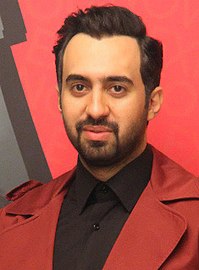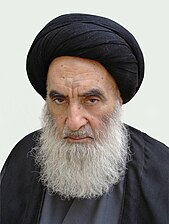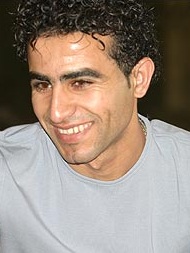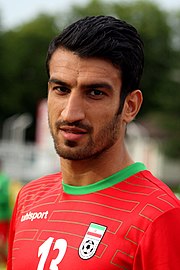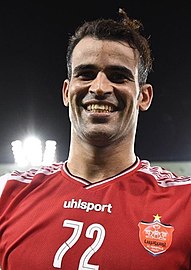
Ahvaz, or Ahwaz, is a city in the Central District of Ahvaz County, Khuzestan province, Iran. It serves as capital of the province, the county, and the district. It is home to Persians, Arabs, Bakhtiaris, Dezfulis, Shushtaris, and others. Languages spoken in the area include Persian, Arabic, Luri and dialects such as Bakhtiari, Dezfuli and Shushtari.
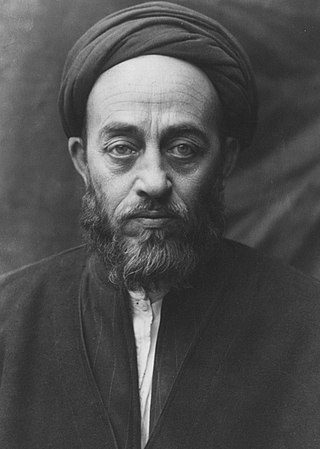
Muhammad Husayn Tabataba'i was an Iranian scholar, theorist, philosopher and one of the most prominent thinkers of modern Shia Islam. He is perhaps best known for his Tafsir al-Mizan, a twenty-seven-volume work of tafsir, which he produced between 1954 and 1972. He is commonly known as Allameh Tabataba'i and the Allameh Tabataba'i University in Tehran is named after him.
Nouri Khodayari was a Iraq–Iranian football player. He was born in Baghdad and played for Al-Omma and Aliyat Al-Shurta. He was known in Iraq as Nouri Qaraman. He was a Fayli Kurd and because he did not possess a certificate of nationality he was unable to sign for Aliyat Al-Shurta, which was why he left Iraq as he was unable to sign for any club. Khodayari died at dawn on March 6, 2013 in Ahvaz after a heart attack. He is survived by five children, two sons and three daughters.

Ali Haghshenas, is an Iranian Writer, Historian, Journalist and sports executive.

The Ministry of Cooperatives, Labour, and Social Welfare is an Iranian government body responsible for the oversight of Cooperative business, regulation and implementation of policies applicable to labour and social affairs. It also oversees the Social Security of Iran. The social security program was formed on 3 August 2011 to insure the well-being of the people in Iran.
The 2012–13 Azadegan League was the 22nd season of the Azadegan League and 12th as the second highest division since its establishment in 1991. The season featured 19 teams from the 2011–12 Azadegan League, three new teams relegated from the 2011–12 Persian Gulf Cup: Shahin Bushehr, Shahrdari Tabriz and Mes Sarcheshmeh and four new teams promoted from the 2011–12 2nd Division: Esteghlal Ahvaz as champions, Gostaresh Foulad and Hafari Ahvaz. Alvand Hamedan replaced PAS Novin Hamedan, Bargh Shiraz replaced Steel Azin and Sang Ahan replaced Tarbiat Yazd. The league started on 13 September 2012 and ended on 16 April 2013. Gostaresh Foulad and Esteghlal Khuzestan won the Azadegan League title for the first time in their history. Gostaresh Foulad and Esteghlal Khuzestan promoted to the Persian Gulf Cup.
Operation Fath 1, or Operation Wahdat, was a joint Iranian and Iraqi Kurdish special operation conducted by Iran's IRGC special forces and Iraqi Kurdish partisans of Patriotic Union of Kurdistan (PUK) in 11 and 12 October 1986 in Kirkuk area of northern Iraq during the Iran–Iraq War. The Iranian and Kurdish forces infiltrated into the area and successfully attacked economic and military targets with minimal losses of their own.
The Specialized library on Islam and Iran was established on 1995 in Qom, Iran. This library contains resources, especially regarding the history of Iran and history of Islam. The library is the first specialized history library in Iran and the largest specialized history library in the Middle East.

Abbas ibn Asadullah bin Ali al-Khalili al-Najafi, also known as Abbas al-Khalili, and Abbas Khalili was an Iraqi-born Iranian diplomat, newspaper publisher, poet and novelist. He was a pillar of the Najaf revolt over the British Mandate in 1918, and was sentenced to death, eventually fleeing to Iran, where spent the rest of his life. The Iranian government's criticism of his newspaper and writing intensified. By 1949, the Iranian government sent him as the Iranian Emperor's ambassador to the Ethiopian Empire and Yemen.

Muhammad Taha al-Huwayzi was an Iranian-Iraqi Ja'fari jurist, religious teacher and poet. He was born in Najaf to a father from Al-Huwayza, and studied early education from him, then became a student of Muhammad Husayn Isfahani for a long time. After the death of his father, he moved to Al-Huwayza in 1927, worked in agriculture, then returned to Najaf in 1946, from there to Qom in Iran, where he studied under Hossein Borujerdi, he who entrusted him for his religious educational institute. In Qom, he held a madrasah seminar in which he taught Arabic language and poetry. In his last years, he moved to Ahvaz for Shariah service until his death at the age of 69. Even though he was a Twelver Shia religious teacher in profession, Al-Huwayzi considered one of the most prominent figures of Khuzestani Arabs in Arabic literature, and left behind a collection of poetry and prose letters.

Sayyid Muhammad bin Fadlallah al-Sarawi, honorifically titled as Thiqat al-Islam, also known as Muhammad Thiqat al-Islam was an Iranian-Iraqi Ja'fari jurist, writer and poet. He has been renowned at the end of the Qajar era, i.e. the early twentieth century, as a bilingual poet in Persian and Arabic. He was born in Pahneh Kola, a village of Sari to a Tabari Musawi family. He first started his religious educations with his father then moved to Ottoman Iraq and studied from ulema of Najaf and Samarra, such as Mirza Shirazi. His efforts to promote da'wah in Iran failed. As a Twelver Shia mujtahid, he settled in Najaf from 1901 until his death, left behind two poetry collections and many books on fiqh, most of them are manuscript.
Muhammad-Amin al-Imami al-Khu'i, honorifically titled as Sadr al-Islam was an Iranian Ja'fari jurist and writer. An Azeri-Asadi by ancestry, Najafi by birth and Khoei by origin, he was recognized as a first-class mujtahid of Tehran from 1920 to the 1940s, and played an effective role in post-constitutional years. A well-known religious historian and author of many fiqh-related works in Arabic and Persian, however, most have remained as handwritten. In addition, Al-Khu'i was noticed as a book collector and scribe of rare books. He died in Tehran at the age of 63.

Sayyid Ibrahim al-Musawi al-Zanjani was an Iranian Ja'fari jurist and writer, best known for his works on various Islamic topics via Twelver Shia outlook, which most of them were published in the successive years of the late 1970s and early 1980s. Born in Sain Qaleh village, then part of Abhar to a well-known Musawi family. After studying in Qom, he went to Najaf and stayed there for about 31 years. He also lived in Kuwait and Syria for many years, fulfilling his Sharia and educational duties. He died at the age of 74 and buried next to the grave of his father in Radekan, Qazvin.
Ahmad bin Ismail al-Jazyiri al-Najafi ; died 1736) was an Iranian-Iraqi Ja'fari jurist and writer, best known for his 1726 work Qalāʼid al-durar fī bayān āyāt al-aḥkām bi-al-Athār which is written about Quran-Fiqh relation by focusing on juristic verses.
Ahmad bin Muhammad al-Muhsini was an Eastern Arabian-Iranian Ja'fari jurist and writer. He was born in Medina during his father's travels and grew up in Al-Ahsa, Eastern Arabia. He went to Iraq to complete his religious education and studied with Ja'far Kashif al-Ghita', Muhammad Husayn al-Araji al-Kazemi, M.M Bahr al-Ulum and the others. Then he settled with his family in Dowraq as a Shaykhi mujtahid, where he worked as a religious and spiritual leader for the Twelver Shiites in the region of Arabistan in the early years of Qajar Iran, from 1799 until his death during 1830s plague epidemic. Al-Muhsini left behind many handwritten books, booklets, epistles and poetry.
Sayyid Amir Mahmud Anvar ; 15 November 1945 – 3 December 2012) was an Iranian literary academic and poet. Born in Tehran into a notable Musawi family. From the late 1960s to 2010, he was one of the prominent professors of Tehran University in fields of Arabic and Persian literature, plus Islamic mysticism. Honored by number of first-class Iranian cultural awards, he dealt with Twelver Shia religious and Iranian national matters in his poetry and renowned as a bilingual poet in Persian and Arabic. Anvar died at the age of 67 in his birthplace and was buried in Behesht-e Zahra.
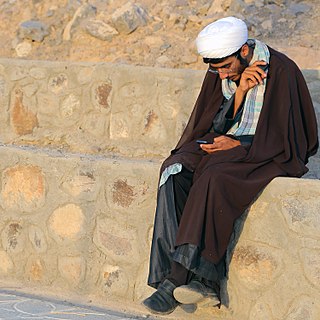
Ammāmeparāni or "knocking off the turban" refers to a protest action by Iranians in which they throw the turban off the head of a mullah in order to express their disgust with the Shia clergy and therefore insult it. During the Mahsa Amini protests in Iran of 2022, people would take videos while knocking off turbans and publish them on social media.


